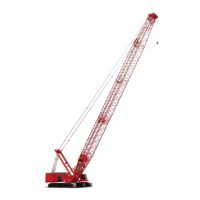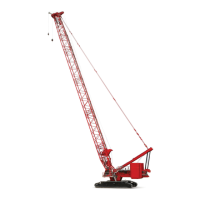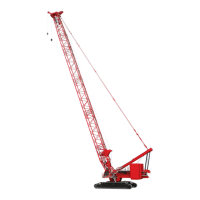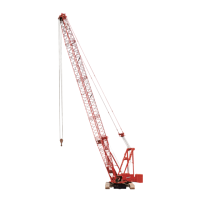HOISTS MLC300 SERVICE/MAINTENANCE MANUAL
5-10
Published 11-22-17, Control # 257-02
DRUM 3—AUXILIARY REAR HOIST
See Figure 5-6 and Figure 5-7 for the following descriptions.
Drum 3 Overview
Drum 3 is powered by a closed-loop hydraulic system
consisting of a variable displacement hydraulic pump and a
variable displacement hydraulic motor. The cross-port orifice
between the motor ports A and B assists in providing smooth
drum operation.
The system contains a drum brake that applies whenever the
drum is not being operated.
Drum 3 Brake Overview
A brake is attached to the input of the drum 3 gearbox
located between the gearbox and the motor. The brake is
controlled by joystick movement and the drum 3 park brake
switch. The brake is applied by spring force and released by
hydraulic pressure.
The brake must be fully released to allow the drum to rotate
for hoisting and lowering operations. To accomplish this, the
brake pressure must be above 16 bar (232 psi). Any
pressure below this could cause the brakes to remain
partially applied, which could damage the drum brake
system.
Only when predetermined conditions are met will the control
system actively release the drum brake. If hydraulic pressure
or electric current is lost, spring force applies the brake,
stopping the drum and holding it in position.
Drum 3 Brake Operation
UN-PARK Operation
Joystick J2 sends 24 V
DC
to the drum 3 park switch. The
park switch is closed in the UN-PARK position, causing the
switch to send 24 V
DC
back to joystick J2. Joystick J2
communicates the un-park command to the CCM-10 control
module via the controller area network bus (CAN Bus).
The drum brake remains engaged until drum 3 joystick J5 is
moved in either direction to hoist or lower a load.
When moved, joystick J5 communicates this information to
the CCM-10 control module via the CAN Bus.
When the CCM-10 control module receives both the un-park
command from joystick 2 and a hoist/lower command from
joystick 5, the CCM-10 control module relays the un-park
command to the CCMC11 control module via the CAN Bus.
Upon receiving the un-park command, the CCMC11 control
module sends 24 V
DC
to the drum 3 brake release solenoid
valve, energizing the solenoid. The solenoid valve shifts
position, routing hydraulic fluid to the drum brake cylinder,
releasing the brake.
ON-PARK Operation
When the drum 3 park switch is in the ON-PARK position,
the park switch is open, sending 0 V
DC
back to joystick J2.
Joystick J2 communicates the park command to the CCM-10
control module via the CAN Bus, which then relays the
command to the CCMC11 control module.
Upon receiving the park command, the CCMC11 control
module sends 0 V
DC
voltage to the drum 3 brake release
solenoid valve, de-energizing the solenoid. This causes the
solenoid valve to return to the default position, allowing the
hydraulic fluid in the brake cylinder to flow through the drum
3 brake release valve, then back to the tank. The reduced
hydraulic pressure allows spring force to apply the drum
brake.
When the drum 3 park switch is in the ON-PARK position,
joystick J5 is inoperable.
Drum 1/3 Diverting
NOTE: Drums 1 and 3 cannot be operated at the same
time. The unused drum must always be parked.
The hydraulic circuits of drum 1 and drum 3 use three
hydraulic valves to divert the hydraulic fluid to the motor of
the selected drum. The valves are as follows:
• Drum 1/3 selector solenoid valve
• Drum 1/3 single diverter valve
• Drum 1/3 double diverter valve
When drum 1 is parked and drum 3 is un-parked, the
CCMC11 control module energizes the drum 1/3 selector
solenoid valve.
CAUTION
Possible Machine Damage!
When raising or lowering a load, do not use the drum park
switch to stop the load movement, since this could cause
damage to the boom. Use the joystick for a controlled
smooth stop.

